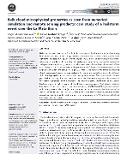Bulk cloud microphysical properties as seen from numerical simulation and remote sensing products: case study of a hailstorm event over the La Plata Basin

Autor
Vara-Vela, Angel Liduvino
Vendrasco, Eder Paulo
Benavente, Noelia Rojas
de Morais, Marcos Vinicius Bueno
Martins, Jorge Alberto
Phillips, Vaughan Trevor James
Goncalves, Fabio Luiz Teixeira
Dias, Maria Assuncao Faus da Silva
Datum vydání
2024Publikováno v
Journal of Southern Hemisphere earth systems scienceRočník / Číslo vydání
74 (2)ISBN / ISSN
eISSN: 2206-5865Metadata
Zobrazit celý záznamKolekce
Tato publikace má vydavatelskou verzi s DOI 10.1071/ES23006
Abstrakt
Hailstorms develop over the La Plata Basin, in south-eastern South America, more often during later winter and early austral spring, between September and October. These systems have significant socioeconomic impacts over the region. Thus, a better understanding of how atmospheric drivers modulate the formation of hailstorms is important to improve the forecast of such phenomena. In this study, we selected a hailstorm event observed over the eastern La Plata Basin during 14-15 July 2016 to evaluate the performance of the Brazilian developments on the Regional Atmospheric Modelling System (BRAMS) model. The ability of the model in simulating cloud microphysical properties was evaluated by comparing simulations driven by different global forcings against in situ and remote sensing observations. The model results showed good skill in capturing the basic characteristics of the thunderstorm, particularly in terms of the spatial distribution of hydrometeors. The simulated spatial distribution of hail covers locations where hail fall was reported. The BRAMS simulations suggest that, despite relatively low values of the convective available potential energy (CAPE) (700-1000 J kg(-1)), environments with strong 0-8-km bulk shear (60-70 kt, similar to 30.9-36.0 m s(-1)) can promote the formation of ice clouds and hail fall over the eastern La Plata Basin. To be more conclusive, however, further research is needed to understand how different combinations of CAPE and shear affect hail formation over the region.
Klíčová slova
BRAMS model, cloud microphysics, hailstorms, La Plata Basin, numerical simulation, precipitation, remote sensing, SALLJ event,
Trvalý odkaz
https://hdl.handle.net/20.500.14178/3016Licence
Licence pro užití plného textu výsledku: Creative Commons Uveďte původ-Neužívejte dílo komerčně-Nezpracovávejte 4.0 International





